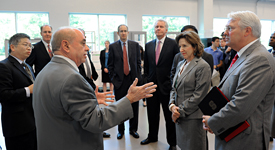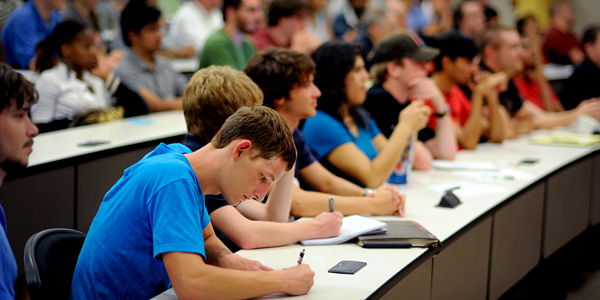NC State colleges and divisions are struggling to tighten their belts once again as the university trims $23 million from its budget to absorb a 5-percent reduction in state funding. Vice chancellors and deans have until Friday, Sept. 6, to submit budget reduction plans to Holladay Hall.
Administrative departments will cut a relatively larger share of their budgets to help soften the impact on colleges and academic programs. But students are likely to see a reduction in the number of classes and seats available and in the amount of academic advising offered, college officials say. The full impact won’t be known until late September.
This year’s drop in state support for NC State is much less than the $53-million reduction in 2009 that resulted in the elimination of 440 faculty and staff positions, and the loss of 300 class sections and 9,750 seats. And it’s less than a third of the $79-million cut in 2011 that cost 753 positions and further reduced academic capacity.
But the previous reductions have taken their toll, making this round of cutbacks particularly challenging, campus leaders say. Plus, revenue from federal research grants has fallen this year due to automatic spending cuts built into the federal budget.
Tough Timing

The timing could hardly be worse, hitting NC State just as it begins to implement an ambitious strategic plan that calls for investments in faculty and infrastructure to improve student success, confront society’s grand challenges and drive economic development.
“As a university we have undergone significant restructuring to allow us to focus our resources more effectively on our core mission,” says Provost Warwick Arden. “We’ve made tremendous gains toward our strategic goals. The challenge for us all will be to maintain this momentum in an increasingly difficult financial environment.”
For many administrators, budget woes are the new normal.
“I’ve been a dean for five years, and we’ve had budget cuts for four of those years,” says Jeff Braden, dean of the College of Humanities and Social Sciences. “My budget is $10 million lighter than when I started.”
Where to Cut?
Like most college administrators, Braden is forced to cut a budget that is overwhelmingly weighted toward personnel. The dean led CHASS through a reorganization of business services in 2011 to improve efficiency and save money. It’s unlikely he can make the required $1.1 million reduction this year without eliminating teaching jobs.

“The biggest impacts for us will be moving faculty and grad students off of state appropriated funding,” he says. “We can find other funding sources for many, but not all of them.”
A dozen or more positions may be eliminated, along with thousands of class seats – many in courses that are required for graduation.
“We’ve been so aggressive in squeezing efficiencies that any additional reduction in state funding affects teaching and advising,” Braden says. “The result is fewer people, fewer courses being taught and fewer hours of advising. Long-term, we’re on an unsustainable path.”
It’s All Connected
The path isn’t any easier in the College of Engineering, where Dean Louis Martin-Vega is weighing deep cuts in programs that support student research. A popular Ph.D. fellowship program may lose half its funding, he says, while financial support for undergraduate research may be completely eliminated – adversely affecting dozens of top students.

It’s a vicious cycle: Cutting teaching assistant positions leads to a drop in Ph.D. enrollment, and puts an increased teaching load on faculty, resulting in less time for research and fewer research dollars coming into the college.
“In long run, you’re looking at a drop in the number of faculty,” he says. “It’s all connected.”
The loss of $2.2 million in state funds is particularly frustrating at a time when the college is rising in reputation and economic impact. It’s the only school in the nation leading two active NSF engineering research centers, including a smart grid center credited with sparking a clean energy boom in the region.
“One faculty member in our college supports three to four Ph.D. students and brings in an average of $300,000 in research funding a year, often more,” he says. “If we have 20 fewer faculty, you do the numbers. The numbers are simple; this isn’t rocket science.”
No Fat Left
The numbers are no better in the College of Agriculture and Life Sciences and the College of Natural Resources, where administrators are also coping with cuts in their agricultural research budgets and cooperative extension budgets. CALS faces the biggest reduction of any college, losing $4 million in state funding and more than $1.7 million in federal research dollars. CNR faces the loss of $360,000 in state funds.

“There’s no fat left in our budget,” says CNR Dean Mary Watzin. “I expect that’s true for all the other colleges across campus. I don’t know how we can absorb these reductions without some impacts on our students.”
The college may drop some courses with low enrollment while pursuing money-saving efficiencies in the dean’s office. On the revenue side, CNR is working to increase income from research, donor giving and entrepreneurship, Watzin says.
On Centennial Campus, the College of Textiles is facing tough choices, as well. Dean Blanton Godfrey says the immediate impact of a $249,000 reduction in state funding is to defer the filling of three open faculty positions. The college will also reduce class sections, classes offered and student support.
In the College of Design, administrators say they have no choice but to reduce spending for outreach and community engagement while protecting academic programs as much as possible. The college’s Prague Institute will become self-supporting, says Dean Marvin Malecha. The college faces a $240,000 cut in state funds.
Limited Options

It’s not just colleges facing difficult decisions. NC State’s Office of Information Technology is looking for ways to absorb a $1.2-million reduction while maintaining critical services on the high-tech campus. There are no attractive options, says communications director Stan North Martin.
“We’re working with colleges and units across campus to determine which services we can stop that will do the least amount of harm,” he says. “But there will be an impact on the services we provide.”
For example, OIT could cancel some of the service contracts it maintains on equipment. If it does, and an IT service goes down, it might take a couple of days rather than hours to get it back online. Eliminating positions is tough, too.
“There are many areas where we’re one person deep,” he says.
It’s not as though the IT budget is big to begin with, especially considering the size of NC State’s student body, and the complexity of its research infrastructure. The university spends about two-thirds as much as its peer institutions on IT support, Martin says.
Step Up Our Game

Administrators face similar concerns in the Facilities Division, where they must cut more than $2 million from operations plus $1.3 million from utilities.
“When you curtail regular maintenance, system failures become more common,” warns Associate Vice Chancellor Kevin MacNaughton. “The cut to facilities maintenance is exacerbated by the five-year drop-off we’ve experienced in capital renovation and repair funding. The resources to respond to these failures just won’t be there.“
The reduction in the utilities budget puts more pressure on the campus community to conserve energy.
“We’ve made great strides in taking individual responsibility to save energy in our offices, research labs and instructional spaces,” MacNaughton says. “We need to step up our game, because not paying the power or water bill is obviously not an option.”
To learn more about the budget reductions, read a memo from Provost Warwick Arden and Vice Chancellor Charles Leffler. The memo includes a chart with budget reduction allocations by college/unit.
- Categories:



